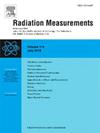用光纤剂量计模拟和测量HDR近距离放射治疗源剂量参数
IF 2.2
3区 物理与天体物理
Q2 NUCLEAR SCIENCE & TECHNOLOGY
引用次数: 0
摘要
本研究的目的是评估使用基于CsI(Tl)的光纤剂量学系统对Flexisource 192Ir HDR近距离治疗源进行TG-43剂量学表征的可行性。研究重点是各向异性和径向剂量函数测量,并评估荧光和切伦科夫辐射对信号精度的影响,并通过TOPAS蒙特卡罗模拟进行验证。掺杂碘化铯(CsI(Tl))闪烁晶体在定制设计的PMMA幻影中使用。该实验使用Flexitron后置装载机和192Ir Flexisource进行,测量距离为1.5-6厘米,极角为20°-155°,增量与已发表的研究结果一致。收集了全面的剂量学数据,揭示了荧光和切伦科夫辐射对各向异性函数测量的影响。放射剂量函数与模拟结果吻合良好,但由于治疗计划的限制,出现了较小的偏差。TOPAS蒙特卡罗模拟结果与实验结果一致,实验数据的最大绝对差值为0.035,各向异性函数验证与已发表参考数据的最大偏差为2.6%,进一步证实了实验方法和仿真模型的可靠性。这些发现强调了在探测器信号响应中考虑荧光和切伦科夫辐射的重要性。与早期主要关注信号去除或硬件抑制技术的方法不同,本研究展示了将这些贡献直接集成到校准模型中,以提高剂量学精度。通过改进这些校准方法,光纤检测器可能进一步发展成为简单、准确和临床可行的近距离治疗应用工具。本文章由计算机程序翻译,如有差异,请以英文原文为准。
Simulation and measurements of HDR brachytherapy source dosimetric parameters using a fiber-optic dosimeter
The aim of this study is to evaluate the feasibility of using CsI(Tl)-based fiber-optic dosimetry system for TG-43 dosimetric characterization of the Flexisource 192Ir HDR brachytherapy source. The investigation focuses on anisotropy and radial dose function measurements and assesses the impact of fluorescence and Cherenkov radiation on signal accuracy, with validation through TOPAS Monte Carlo simulations.
Thallium Doped-Cesium Iodide (CsI(Tl)) scintillation crystals were used within a custom-designed PMMA phantom. The experiment, conducted with a Flexitron afterloader and 192Ir Flexisource, involved measurements at distances of 1.5–6 cm and polar angles of 20°–155°, with increments matching those in the published studies.
Comprehensive dosimetric data were collected, revealing the influence of fluorescence and Cherenkov radiation on anisotropy function measurements. The radial dose function showed good agreement with simulation, with minor deviations attributed to limitations in the treatment planning. TOPAS Monte Carlo simulations demonstrated consistent agreement with experimental results, yielding a maximum absolute difference of 0.035 in the experimental data and a maximum deviation of 2.6% in anisotropy function validation against published reference data, further confirming the reliability of both the experimental approach and the simulation model.
These findings underscore the importance of accounting for fluorescence and Cherenkov radiation in detector signal response. Unlike earlier approaches that primarily focused on signal removal or hardware suppression techniques, this study demonstrates the integration of these contributions directly into calibration models to improve dosimetric precision. By refining these calibration methods, fiber-optic detectors may be further developed into simple, accurate, and clinically viable tools for brachytherapy applications.
求助全文
通过发布文献求助,成功后即可免费获取论文全文。
去求助
来源期刊

Radiation Measurements
工程技术-核科学技术
CiteScore
4.10
自引率
20.00%
发文量
116
审稿时长
48 days
期刊介绍:
The journal seeks to publish papers that present advances in the following areas: spontaneous and stimulated luminescence (including scintillating materials, thermoluminescence, and optically stimulated luminescence); electron spin resonance of natural and synthetic materials; the physics, design and performance of radiation measurements (including computational modelling such as electronic transport simulations); the novel basic aspects of radiation measurement in medical physics. Studies of energy-transfer phenomena, track physics and microdosimetry are also of interest to the journal.
Applications relevant to the journal, particularly where they present novel detection techniques, novel analytical approaches or novel materials, include: personal dosimetry (including dosimetric quantities, active/electronic and passive monitoring techniques for photon, neutron and charged-particle exposures); environmental dosimetry (including methodological advances and predictive models related to radon, but generally excluding local survey results of radon where the main aim is to establish the radiation risk to populations); cosmic and high-energy radiation measurements (including dosimetry, space radiation effects, and single event upsets); dosimetry-based archaeological and Quaternary dating; dosimetry-based approaches to thermochronometry; accident and retrospective dosimetry (including activation detectors), and dosimetry and measurements related to medical applications.
 求助内容:
求助内容: 应助结果提醒方式:
应助结果提醒方式:


